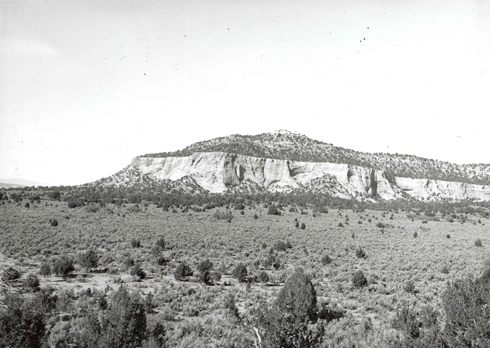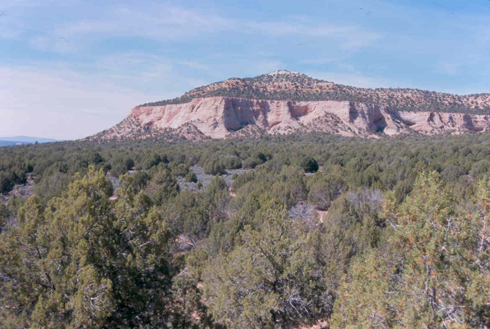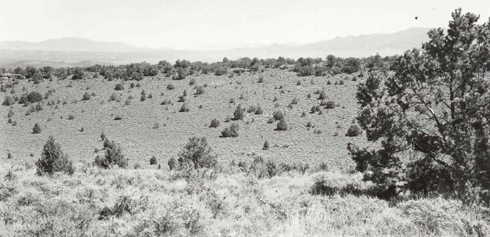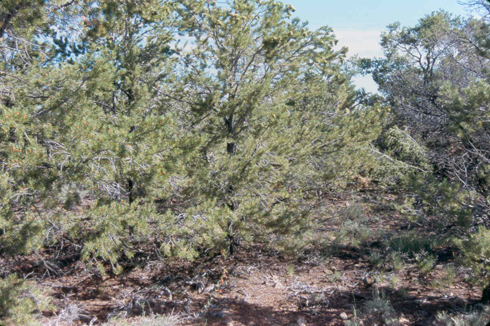The Evils of Pinyon and Juniper
Charles E. Kay. 2010. The Evils of Pinyon and Juniper. Mule Deer Foundation Magazine Vol 10(5): 6-13
Dr. Charles E. Kay, Ph.D. Wildlife Ecology, Utah State University, is the author/editor of Wilderness and Political Ecology: Aboriginal Influences and the Original State of Nature [here], author of Are Lightning Fires Unnatural? A Comparison of Aboriginal and Lightning Ignition Rates in the United States [here], co-author of Native American influences on the development of forest ecosystems [here], and numerous other scientific papers.
Full text with photos (click on photos for larger images):
PINYON PINES and upright junipers are found throughout the West. Ash and red berry juniper occur in Texas, while western juniper is most abundant in the interior Pacific Northwest. One-seeded and Utah juniper are widespread in Nevada, Utah, and on the Colorado Plateau, whereas Rocky Mountain juniper can be found in Idaho, Montana, and Wyoming. All junipers have small, scale-like leaves and are often called cedars due to their aromatic wood. In fact, the most widely occurring juniper in the East is known as eastern red cedar. In addition to the tall, or upright junipers, there are a few, low-growing species of which horizontal and common are the mostly likely to be encountered.
Pinyons, on the other hand, are represented by only two species. Single-leaf pinyon has only one needle per fascicle, while two-needle pinyon has two needles per fascicle or bundle. Pinyons are abundant in Nevada, Utah, Colorado, Arizona, and New Mexico. Pinyons and junipers are the most drought tolerant of all western conifers. In addition, pinyons and junipers are chemically defended by terpenes and other compounds that inhibit ruminant microbial digestion. Livestock will generally not consume pinyon or juniper and mule deer will generally browse juniper only if the animals are starving. Pinyons and most junipers are also extremely invasive.
Prior to European settlement, it has been estimated that pinyon and juniper covered 7.5 million acres in the West, while today P-J has infested over 75,000,000 acres, a ten-fold increase. Moreover, the number of trees per acre has increased 10 to 100 fold. I have compiled 1,879 repeat photosets in southern Utah and of that total, 1,007 photo pairs depict pinyon and/or juniper. In 96% of those cases, P-J increased, often dramatically. As pinyon and juniper have expanded their range and thickened, the production of shrubs, forbs, and grasses has declined precipitously. In many stands, understory forage production is near zero, and as understory species decrease, soil erosion increases, even on ungrazed sites. In New Mexico’s Bandelier National Monument, for instance, as pinyon and juniper have thickened, understory species have been eliminated, which has lead to a drastic increase in soil erosion threatening the park’s archaeological sites.
Closed-canopy stands of pinyon-juniper are rare in early historical photographs. Instead, most stands once consisted of a few widely-spaced pinyon and/or juniper with abundant grasses, shrubs, and forbs in what could be characterized as a savanna. With time, however, those stands have infilled until today many pinyon-juniper sites have a closed canopy. Pinyon and juniper have also extended their range by invading grasslands, sagebrush, and other plant communities. Historically, old-growth pinyon-juniper was restricted to rocky outcroppings, areas with poor soils, and other fire refugia. Crown-fire behavior in pinyon-juniper is increasingly common in the West today, but there is no evidence that was the norm prior to European settlement and the expansion and infilling of pinyon-juniper woodlands. Only 3 or 1,007 historical photos taken in southern Utah show any evidence of stand-replacing fire in pinyon-juniper until modern times. The same is true in other areas.
Now, pinyon and juniper do provide hiding and thermal cover for mule deer, but as P-J has invaded winter ranges, millions of acres of once productive habitat have been, and are being, lost. Biodiversity has decreased, as have sage-obligate species, such as sage grouse, which could soon be added to the Endangered Species List. Water yields and spring flows have also declined, as pinyon and juniper consume more soil moisture than forage species. Professors David Engle, Bryan Coppedge, and Samuel Fuhlendorf have characterized the expansion of juniper and other woody vegetation as a “Green Glacier” and have noted that it is “changing endemic avifauna to an extent equivalent to that of the Pleistocene on the Great Plains.” They went on to concluded that “the Green Glacier or woody plant encroachment into grasslands is creating a 21st century environmental crisis that might well surpass the ecological impact of the 20th century Dust Bowl.” Pinyon and juniper also provide ideal stalking cover for mountain lions and bears.
Four hypotheses have been advanced to explain pinyon and/or juniper expansion in western North America since European settlement - -livestock overgrazing, carbon dioxide enrichment, climatic variation, and reduced fire frequency. Several authors have suggested that overgrazing by domestic sheep and cattle has led to an increase in pinyon and juniper. According to this view, overgrazing reduced grass competition and increased bare soil, which allowed pinyon and juniper to increase. Other researchers, however, have compared pinyon-juniper encroachment on grazed versus ungrazed sites and reported that pinyon and juniper increased irrespective of grazing treatment.
Similarly, although increased atmospheric carbon dioxide enhances the growth of woody species, there is little evidence to suggest that factor alone is responsible for the westwide expansion of pinyon and juniper. In addition, climatic conditions in the West have generally become drier and warmer, which should not favor pinyon-juniper expansion. Yet, not only have pinyon and juniper expanded but they have moved downslope into more xeric environments. Thus, there is no evidence that climatic variation has been driving pinyon-juniper encroachment. This leaves fire, or the lack thereof, as the most logical explanation for the expansion of pinyon and juniper. Both pinyon and juniper have relatively thin bark and both are easily killed by even low-intensity burns. Moreover, since pinyon and juniper usually have branches down to ground level, it is very easy to ignite entire trees, even with cool-burning grass fires.
The fire hypothesis involves three factors, two that are commonly mentioned in the scientific literature and one that, to date, has largely been ignored. Fire suppression is the factor most often mentioned followed by livestock-induced reduction in fine fuels. By grazing grasses and other range plants, domestic sheep and cattle reduce both the amount and distribution of fine fuels that are necessary to carry fire through non-forested communities. While all this is true, I would add a third component, which I believe is even more important than the first two — aboriginal burning, both inadvertent escaped campfires, as well as purposeful landscape ignitions.
In a recent scientific publication, I compared known lightning-ignition rates on every national forest in the continental United States with potential aboriginal-ignition rates based on estimates of indigenous populations and the number of fires each native person started per year. Using realistic estimates of native populations, as well as the number of fires each indigenous person started per year, potential aboriginal rates were 270 to 35,000 times greater known lightning-ignition rates. Thus, the dominant ecological force for the last 10,000 years has most likely been aboriginal burning. Fires, through frequent, were of a low intensity as most aboriginal burning was conducted during spring or fall when there was little chance of extreme fire behavior. Moreover, once an aboriginal fire-regime was established then any lightning-caused fires behaved like human-set fires. Again, large scale, high-intensity crown fires in pinyon-juniper, though increasingly common today, seldom occurred in the past.
If there are sufficient fine fuels and if human life and property are not an issue, fire can still be used to control pinyon-juniper. As stands have thickened and eliminated understory fuels, however, often the only option is mechanical treatment, including chaining, brush-hogging, roller-chopping, and hand clearing, among others. Increasingly, though, various environmental groups are objecting to any manipulation of pinyon-juniper, contending that it is “unnatural” to create habitat for mule deer and other species. What those organizations fail to realize, however, is that to return the West to the way it was before European settlement, which appears to be their standard, we need to reduce the area infested with P-J by at least 90 percent. Moreover, since large-scale crown fires are entirely outside the range of historical variability, the only safe way to restore most P-J infested rangelands is with mechanical treatment followed by reseeding. Once areas have been opened up and fine fuels regrown, then it may be possible to reintroduce fire to prevent subsequent reinvasion by pinyon-juniper. The goal is not to create mule deer, or any other habitat per se, but to restore the land to its former productive condition.
Figures 1a and 1b. Pinyon – juniper invasion of Harris Flat in southwestern Utah. Historically, pinyon and juniper were confined to the rocky slopes of Harris point in the distance and the low rocky hill on which the camera station is located. By the time the initial photo was taken in 1936, however, pinyon and juniper had started to invade the sagebrush flat. As pinyon and juniper have increased, sagebrush, grasses, and forbs have declined. Today the site would support a high-intensity crown fire, which historically was not the case. [Click for larger images]
Figures 2a and 2b. This Photo Plot Transect was established by the Forest Service in 1943 to monitor vegetation conditions on a mule deer winter range in southwestern Utah. Historically, there was only a scattering of pinyon and juniper at this location, but by the 1940’s pinyon and juniper had begun to invade the sagebrush community. Today the site is a pinyon-juniper woodland and is no longer used by the wintering deer. [Click for larger images]




